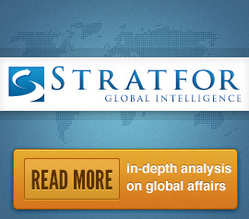The Middle East is one of the most volatile regions in the world - it is no stranger to upheaval. The 2009 uprisings in Iran and the brinksmanship of Mahmoud Ahmadinejad's government were followed by the chaos of the Arab Spring, the spillover of the Syrian conflict into Iraq and a potential realignment of the U.S.-Iranian relationship. Unlike recent years, however, 2015 is likely to see regional Sunni Arab interests realign toward a broader acceptance of moderate political Islam. The region is emerging from the uncertainty of the past half-decade, and the foundations of its future are taking shape. This process will not be neat or orderly, but changes are clearly taking place surrounding the Syrian and Libyan conflicts, as well as the region's anticipation of a strengthened Iran.
The Middle East enters 2015 facing several crises. Libyan instability remains a threat to North African security, and the Levant and Persian Gulf must figure out how to adjust course in the wake of the U.S.-Iranian negotiations, the Sunni-Shiite proxy war in Syria and Iraq, and the power vacuum created by a Turkish state bogged down by internal concerns that prevent it from assuming a larger role throughout the region. Further undermining the region is the sharp decline in global oil prices. While Saudi Arabia, Kuwait and the United Arab Emirates will be able to use considerable cash reserves to ride out the slump, the rest of the Middle East's oil-exporting economies face dire consequences.
For decades, long-ruling autocratic leaders in countries such as Algeria and Yemen helped keep militancy in check, loosely following the model of military-backed Arab nationalism championed by Gamal Abdel Nasser in Egypt. Arab monarchs were able to limit domestic dissent or calls for democracy through a combination of social spending and repression. The United States not only partnered with many of these nations to fight terrorism - especially after September 2001 - but also saw the Gulf states as a reliable bulwark against Iranian expansion and a dangerous Iraq led by Saddam Hussein. Levantine instability was largely contained to Lebanon and the Palestinian territories, while Israel's other neighbors largely abided by a tacit agreement to limit threats emanating from their territories.
Today, Saddam's iron grip on Iraq has been broken, replaced by a fractious democracy that is as threatened by the Islamic State as it is by its own political processes. Gone are the long-time leaders of states like Tunisia, Libya and Egypt. Meanwhile, Algeria, Saudi Arabia and Oman are facing uncertain transitions that could well take place by year's end. The United States' serious dialogue with Iran over the latter's nuclear program, once a nearly unthinkable scenario for many in the Gulf, has precipitated some of the biggest shifts in regional dynamics, especially as Saudi Arabia and its allies work to lessen their reliance on Washington's protection.
The Push for Sunni Hegemony
Riyadh begins this year under considerably more duress than it faced 12 months ago. Not only is King Abdullah gravely ill (a bout of pneumonia forced the 90-year-old ruler to ring in the new year in the hospital and on a ventilator), but the world's largest oil-producing country has also entered into a price war with American shale producers. Because Saudi Arabia and its principal regional allies, Kuwait and the United Arab Emirates, boast more than a trillion dollars in cash reserves between them, they will be able to keep production levels constant for the foreseeable future.
However, other OPEC producers have not been able to weather the storm as easily. The resulting 40 percent plunge in oil prices is placing greater financial pressure on Iran and the Shiite-dominated government in Iraq, Saudi Arabia's largest sectarian and energy rivals. Riyadh's careful planning and building of reserves means the Saudi kingdom's economic security is unlikely to come under threat in the next one to three years. The country will instead continue to focus on not only countering Iran but also rebuilding relationships with regional Sunni actors weakened in previous years.
Riyadh's regional strategy has traditionally been to support primarily Sunni Arab groups with a conservative, Salafist religious ideology. Salafist groups traditionally kept out of politics, and their conservative Sunni ideology was useful in Saudi Arabia's competition against Iran and its own Shiite proxies. Promoting Salafism also served as a tool to limit the reach of more ideologically moderate Sunni political Islamists like the Muslim Brotherhood and its affiliates, groups Riyadh sees as a threat because of their success in organizing grassroots support and fighting for democratic reforms.
With rise of external regional pressures, however, Gulf monarchies such as Saudi Arabia are re-evaluating their relationships with the Muslim Brotherhood. Internal threats posed by Salafist jihadists and a desire to limit future gains by regional opponents are pushing countries such as Saudi Arabia and the United Arab Emirates to try to forge a relationship with the Muslim Brotherhood to limit the risks posed by rival groups in the region.
Restoring relations with the Muslim Brotherhood will also have effects on diplomatic relations. Qatar has long been a supporter of the Muslim Brotherhood, a fact that has strained its relations with other countries - Saudi Arabia, Bahrain and the United Arab Emirates even went so far as to close their embassies in Qatar. However, the continuation of the United States' rapprochement with Iran and Riyadh's own discomfort with the rise of Salafist jihadist groups has made it reconsider its stance on political Islamism. Riyadh, Bahrain and Abu Dhabi's agreement to resume diplomatic ties with Doha, and the latter's consideration of changing its relationships with Egypt and Libya, points to a shift in how the bloc's engagement with the Muslim Brotherhood has the potential to streamline the Gulf Cooperation Council's (GCC) efforts in the region.




